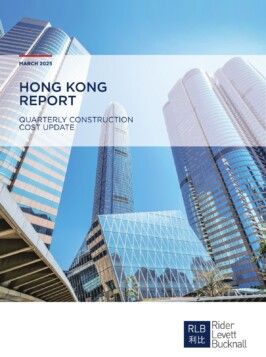According to the latest issue of RLB Construction Cost Update HK Report, the tender prices are forecast to experience modest fluctuations within a narrow range in the coming quarters.
In the fourth quarter of 2024, Hong Kong’s economy stabilized amid subdued global demand, supported by a rebound in tourism and targeted initiatives. The construction sector exhibited a bifurcated performance, with total building and construction expenditure declining 6.5% year-on-year. Private-sector expenditure contracted by 9.3% year-on-year, reflecting developers’ caution in light of elevated borrowing costs and subdued residential sales. Meanwhile, public-sector investment declined 3.0% year-on-year, underscoring sector-wide challenges despite strategic fiscal backing.
The 2025-26 Budget, unveiled in early 2025, reaffirmed the government’s commitment to infrastructure and housing development. The construction sector is set to gain confidence as strategic infrastructure projects move forward at an accelerated pace. Key initiatives include the Northern Metropolis development, which integrates the Hetao Shenzhen-Hong Kong Science and Technology Innovation Cooperation Zone with the San Tin Technopole to boost the innovation and technology (I&T) industry, as well as the expansion of cross-border transport networks across the Greater Bay Area. The 2025/26 Land Sale Programme includes eight residential sites, with no commercial sites planned for sale. To enhance land use flexibility, the government is exploring the re-zoning of selected commercial sites for residential purposes. Over the next five years, the total public housing supply is projected to reach 190,000 units, aligning with long-term housing targets. Additionally, the government, in partnership with the Construction Industry Council, will allocate funding for specialized training programs to address labour shortages through upskilling initiatives.
The public sector is anticipated to remain the primary engine of near-term construction industry growth, supported by sustained fiscal commitments to large-scale projects. While persistent constraints in the property market are likely to temper private-sector activity, tender prices are forecast to experience modest fluctuations within a narrow range in the coming quarters, reflecting the government’s strategic prioritization of public housing and transformative infrastructure investments.
FURTHER INFORMATION:




